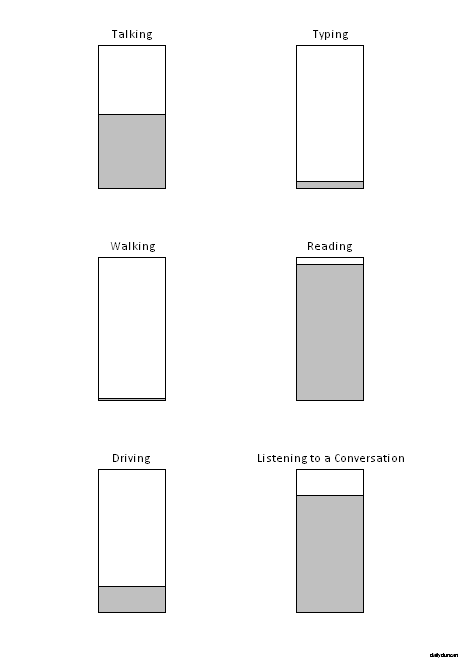The ability to multitask is a trait that many believe does not belong to everyone. It’s often said that the female sex is superior at multitasking or that it’s a learned ability that some never acquire. There are even anecdotes that describe the inability of people with blonde hair to simultaneously walk and chew gum. This example is obviously absurd, as the blonde person would first have to decipher how to open the packaging. Regardless of these commonly held beliefs, the capacity to multitask is one possessed, in some capacity, by all people.
Although the ability may be universal, the degree to which one can multitask largely depends on the complexity and familiarity of the tasks at hand. Most everyone with the ability walk and clap their hands could easily do both at once, but far fewer people could play the piano while reading a book. The ability to multitask has less to do with the number of tasks one is carrying out than the attention required by those tasks.
If we wanted to measure the ability to multitask, we would first have to rate the attention needed for tasks that we perform. After all, some activities, like doing jumping jacks, require the use of our entire body, restricting us from participating in any other physical activities. However, jumping jacks are fairly simple and don’t require much coordination, so our minds are free to do other things. Other tasks, such as reading or drawing, can be done with minimal physical effort, yet demand much our of mental focus.
It might help to think of our capacity to give attention as a reservoir, with each task we take on draining from the pool. If there is not enough attention remaining to perform an additional task, then it can’t be added to our workload without paying inadequate attention to one or more other tasks.
Above are some examples of tasks that require varying levels of attention. As we can see, reading and listening to a conversation are tasks that require a great deal of attention, while walking and typing can be done without much thought. Some tasks, such as walking, actually require so little attention that they hardly register as a conscious act.
It’s important to realize that the degree of attention that a task requires may vary from person to person depending on their abilities and familiarity with the task. If a person finds a task difficult, then it will likely demand more attention than if they found it easy. As we become familiar with movements and patterns, they become easier and therefore require less attention. When we become very familiar with a task, we may even relinquish its control to our subconscious, permitting our mind to focus on other functions. This allows us to do things that would normally require more attention than we can offer, which explains why we sometimes see people eating or reading while driving – a very unwise move.
In the same way that we can allow our subconscious to take control, we can also take conscious command of tasks that normally require little attention. By doing so, we can perform them with extra care and intention. But this may disrupt our normal routines, which can cause us to make errors. This explains why we always screw up when the boss is watching. Another potential hazard when paying too much attention is that some tasks just aren’t meant to be contemplated. If we begin to think about our breathing or our footsteps, we can be driven mad by fixating on a function that should be automatic.
There are many other reasons why a task may require more or less attention, since humans vary greatly in ability and experience. What qualifies as a simple, mindless activity for some could be extremely arduous for others. However, one thing is certain: everyone can multitask.
